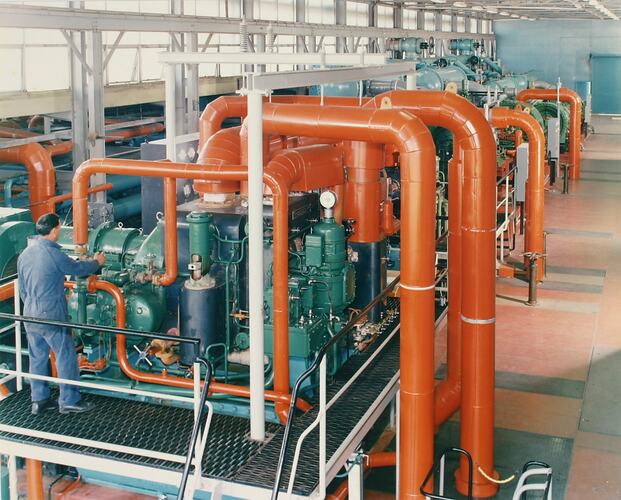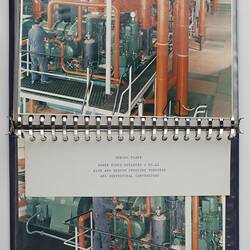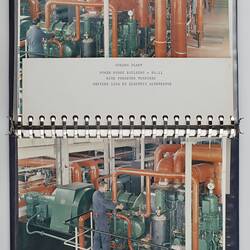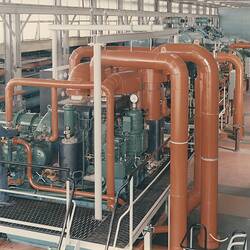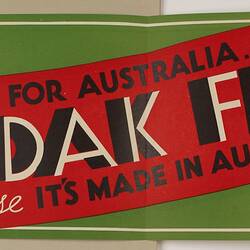Summary
Colour photograph of a Power House operator checking the operation of a high pressure steam turbine driving an electrical alternator located in the Machinery Hall of the Power House, Building 11, at the Kodak factory, Coburg, circa 1963. Further along the line is another high pressure steam turbine-alternator set, one high and one low pressure steam turbine-centrifugal refrigeration compressor sets and two electrical motor driven centrifugal refrigeration compressor sets.
The Power House, Building 11, at the Coburg Factory consisted of an integrated Machinery Hall with its north and south annexes, Boiler Hall, evaporative water cooling towers, 62 metre brick chimney stack, oil bunkers, tank farm and office/amenities block. The fully integrated Power House provided the most efficient use of electricity and fuel oil (and later natural gas) to match the variable load of the factory.
The steam turbine driven equipment shown in the photograph was installed in the existing Machinery Hall a short time after the two 4.5Kg/s oil-fired boilers in the new Boiler Hall were fired up over the period 1960-61 (a third gas-fired 8.8Kg/s boiler was added after 1975 when the older boilers were converted to burning natural gas). The two Allen back pressure steam turbine driven alternator sets (one triple-expansion & one double-expansion) shown in the foreground, used super-heated steam generated from the boilers at 400ºC and 3.1MPa. The larger turbine alternator set was rated at 1.2 MW, and the other set at 0.5 MW respectively (415 V, 50Hz) with the 1.2 MW unit shown in the foreground of the photograph. This represented the power requirements to maintain essential services throughout the factory (the rest being supplied off the Preston City Council grid). There was no interconnection between the electricity systems but individual buildings could be switched to either supply as desired.
Behind the alternator sets and to the right of the photograph, are steam turbines driving two Worthington centrifugal refrigeration compressors, each rated at 3MW (850 Ton), which provided chilled water at 3ºC for cooling and air-conditioning throughout the factory. One was a back pressure turbine using steam directly from the boilers, while the other was a low pressure fully condensing turbine using steam at 70KPa. The low pressure steam (70 KPa) from the back pressure turbine passouts was circulated throughout the factory site in an overhead reticulation system which was lagged and clad for protection and efficiency. Excess low pressure steam, which was not required for heating during summer, was passed through the low pressure turbine to provide additional chilled water capacity. Unsighted in the background are two electrical motor driven 1.6MW (450 Ton) centrifugal refrigeration compressors (installed at an earlier date for the factory start-up period 1958-60), which provided additional capacity to cope with low excess steam or very heavy cooling loads. Maximum efficiency of generation and use of the steam was achieved by balancing the local/grid electrical usage and heating/cooling requirements of the factory over the summer and winter loads. All of this plant was in use until the factory closed in 2004.
Kodak manufactured and distributed a wide range of photographic products to Australasia, such as film, paper, chemicals, cameras and miscellaneous equipment. Its client base included amateur and professional photographers, as well as specialist medical and graphic art professionals who used photography, x-ray and other imaging techniques.
This photograph is part of the Kodak collection of products, promotional materials, photographs and working life artefacts collected from Kodak Australasia in 2005, when the Melbourne manufacturing plant at Coburg closed down.
Description of Content
Photograph of a series of turbines in a factory interior. A man wearing blue overalls is standing on a metal grill platform situated adjacent to the turbine and is monitoring the equipment.
Physical Description
Colour photograph printed on medium weight Kodak paper, landscape format.
More Information
-
Collection Names
-
Collecting Areas
-
Acquisition Information
Donation from Kodak (Australasia) Pty Ltd, Ms. Kate Metcalf - Kodak (Australasia) Pty Ltd, 2005
-
Acknowledgement
Courtesy of Kodak (Australasia) Pty Ltd.
-
Place & Date Depicted
Coburg, Greater Melbourne, Victoria, Australia, 1962-1963
Ritter-Jeppesen took photographs either January 1962 or 1963. -
Organisation Depicted
Kodak (Australasia) Pty Ltd, Coburg, Greater Melbourne, Victoria, Australia, 1962-1963
Ritter-Jeppesen took photographs either January 1962 or 1963. -
Photographer
Ritter-Jeppesen Studios Pty Ltd, Coburg, Greater Melbourne, Victoria, Australia, circa 1963
Ritter-Jeppesen took photographs either January 1962 or 1963. -
Format
Photograph, Colour
-
Inscriptions
Card insert, typed, black ink: 'COBURG PLANT/ POWER HOUSE BUILDING - NO.11/ HIGH AND MEDIUM PRESSURE TURBINES/ AND CENTRIFUGAL COMPRESSORS'
-
Brand Names
-
Classification
Manufacturing & industry, Photographic products, Factory interior views
-
Category
-
Discipline
-
Type of item
-
Image Dimensions - Photograph
238 mm (Width), 193 mm (Height)
-
Keywords
Factories, Manufacturing Plants, Photography, Power Houses, Steam Turbines, Making History - Kodak Collection
